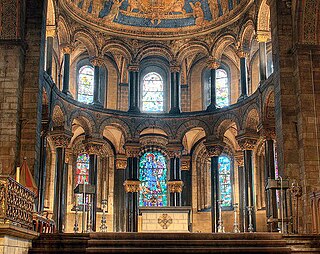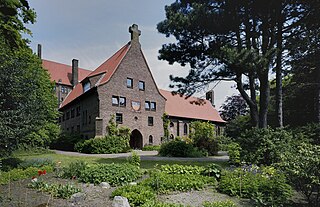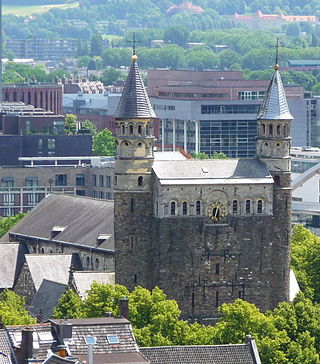
Sint-Truiden is a city and municipality located in the province of Limburg, Flemish Region, Belgium, and has over 41,500 inhabitants, which makes it one of the largest cities in Limburg. The municipality includes the former communes of Aalst, Brustem, Duras, Engelmanshoven, Gelinden, Gorsem, Groot-Gelmen, Halmaal, Kerkom-bij-Sint-Truiden, Melveren, Metsteren, Ordingen, Runkelen, Velm, Wilderen, and Zepperen.

Susteren Abbey is a former Benedictine abbey at Susteren near Roermond, in the Dutch province of Limburg, founded in the 8th century. The former abbey church is now St. Amelberga's Basilica.

Mosan art is a regional style of art from the valley of the Meuse in present-day Belgium, the Netherlands, and Germany. Although in a broader sense the term applies to art from this region from all periods, it generally refers to Romanesque art, with Mosan Romanesque architecture, stone carving, metalwork, enamelling and manuscript illumination reaching a high level of development during the 11th, 12th and 13th centuries.

Averbode Abbey is a Premonstratensian abbey situated in Averbode, in the municipality Scherpenheuvel-Zichem, in the Archdiocese of Mechelen-Brussels in Belgium. It was founded about 1134, suppressed in 1797, and reestablished in 1834. Throughout the 20th century the abbey press was a leading children's publisher in Belgium. The church's building is a peculiar synthesis of Baroque and Gothic, with Renaissance ornament details, dominating the monastery complex. The whole structure was built of iron sandstone from Langdorp and white sandstone from Gobertange between 1664 and 1672, after a design by the Antwerp architect Jan Van den Eynde II.

The Basilica of Saint Servatius is a Roman Catholic church dedicated to Saint Servatius, in the city of Maastricht, the Netherlands. The architecturally hybrid but mainly Romanesque church is situated next to the Gothic church of Saint John, backing onto the town's main square, Vrijthof.
Saint Trudo was a saint of the seventh century. He is called the "Apostle of Hesbaye". His feast day is celebrated on 23 November.

Zepperen is a village and a former municipality. It is part of the municipality of Sint-Truiden in the province of Limburg in Belgium.

Rein Abbey is a Cistercian monastery in Rein near Gratwein, Styria, in Austria. Also known as the "Cradle of Styria", it is the oldest surviving Cistercian community in the world.

Munsterbilzen Abbey was an abbey of Benedictine nuns in Munsterbilzen, Limburg, Belgium, founded in around 670 by Saint Landrada. It was plundered by Vikings in 881 but restored. From the 9th century it was dedicated to Saint Amor.

Egmond Abbey or St. Adalbert's Abbey is a Benedictine monastery of the Congregation of the Annunciation between Egmond aan den Hoef and Bakkum in Egmond-Binnen in the municipality of Bergen in the Dutch province of North Holland. Founded in 920-925 and destroyed in the Reformation, it was re-founded in 1935 as the present Sint-Adelbertabdij, in the Diocese of Haarlem.

The Basilica of Our Lady is a Romanesque church in the historic center of Maastricht, Netherlands. The church is dedicated to Our Lady of the Assumption and is a Roman Catholic parish church in the Diocese of Roermond. The church is often referred to as the Star of the Sea, after the church's main devotion, Our Lady, Star of the Sea.

The Doppelkirche Schwarzrheindorf is a Romanesque church in Bonn, North Rhine-Westphalia, Germany. The church was once part of a Benedictine nunnery located at Schwarzrheindorf, now part of Bonn. The "double church" has an upper church dedicated to the Virgin Mary and a lower church dedicated to Pope Clement I. The church is famous for its fine 12th-century frescos.

Ename Abbey (1063–1795) was a Benedictine monastery in the village of Ename, now a suburb of Oudenaarde. It was founded by Adele of France, wife of Baldwin V, Count of Flanders, and was confiscated during the French Revolutionary Wars. It was then sold and dismantled.

Male Castle, Bruges. A community of the Canonesses Regular of the Holy Sepulchre. It originated in Bruges in the 11th century, and between 1954 and 2013 was settled in Male Castle in Male, Sint-Kruis, Bruges, West Flanders, Belgium.

Vlierbeek Abbey is a former Benedictine abbey to the north-east of Leuven in Belgium, in the sub-district Kessel-Lo.

Aduard Abbey is a former Cistercian abbey in the village of Aduard about 8 kilometres to the north-west of Groningen in the Netherlands, founded in 1192 and dissolved in 1580.

Bornem Abbey is the only Cistercian abbey of Common Observance in the Archdiocese of Mechelen-Brussels. The current abbey is the successor of the former St. Bernard's Abbey, Hemiksem, destroyed in the French Revolution. Both are built in honour of Saint Bernard of Clairvaux.

Ninove Abbey was a monastery of the Premonstratensian Order in the center of Ninove, in the province of East Flanders, Belgium. Only the abbey church now remains.

Dendermonde Abbey or the Abbey of Saints Peter and Paul is a Benedictine monastery in Dendermonde (Belgium), which played a role in the Liturgical Movement in Belgium.























